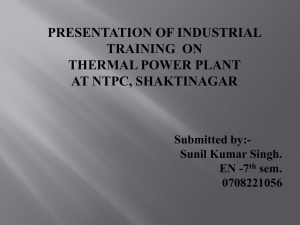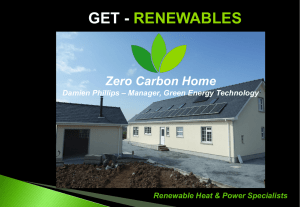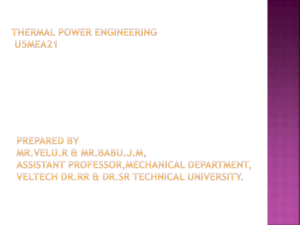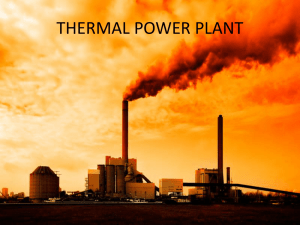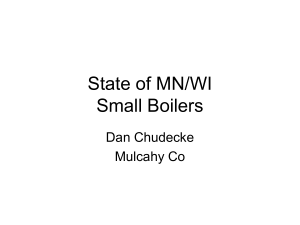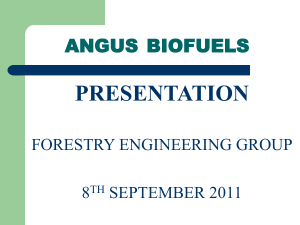STEAM_BOILER
advertisement
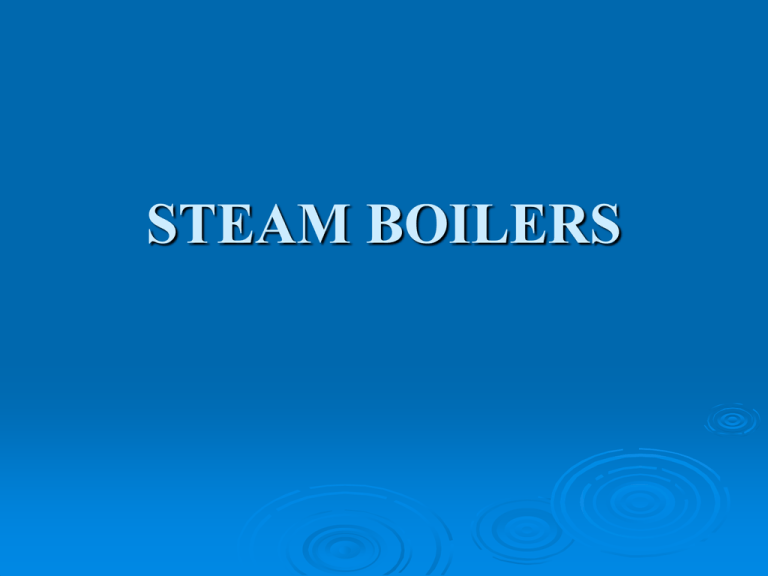
STEAM BOILERS Definition A closed vessel in which steam is produced from water by combustion of fuel Purpose of boilers For generating power in steam engines or steam turbines In textile industries for sizing and bleaching For heating the buildings in cold weather and for producing hot water for hot water supply Primary requirements of a boiler The The water must be contained safely steam must be safely delivered in desired condition (as regard its pressure, temperature, quality and required rate) Boiler terms Shell: Consists of one or more steel plates bent into a cylindrical form and riveted or welded together. The shell ends are closed with end plates Setting: The primary function of setting is to confine heat to the boiler and form a passage for gases. It is made of brick work and may form the wall of the furnace and combustion chamber Grate: it is a platform in the furnace upon which fuel is burnt Furnace: it is the chamber formed by the space above the grate and below the boiler shell, in which combustion takes place. Water space and steam space: the volume of the shell that is occupied by the water is termed as water space while the entire shell volume less the water and tubes is called steam space Mountings: The items which are used for safety of boiler are called mountings Accessories: The items which are used for increasing the boiler efficiency are called accessories Water level: The level at which water stands in the boiler is called water level Refractory: insulation material used for lining combustion chamber Foaming: Formation of steam bubbles on the surface of boiler water due to high surface tension of water Scale: A deposit of medium due to extreme hardness occurring on the water heating surfaces of boiler because of an undesirable condition in the boiler water Blowing off: The removal of mud and other impurities of water from the lowest part of the boiler. Accomplished with the help of blow off cock or valve Lagging: Insulation wrapped on the outside of the boiler shell or steam piping Boiler accessories Feed pumps: Used to deliver feed water to the boiler. It is desirable that the quantity of water supplied should be at least equal to that evaporated and supplied to the engine Two types of which are commonly used as feed pumps are (1) reciprocating pump (2) rotary pump Injector Function of injector is to feed water into the boiler It is commonly employed for vertical and locomotive boilers and does not find its application in large capacity high pressure boilers Also used where the space is not available for the installation of feed pump Economizer Is a device in which the waste heat of the flue gases is utilized for heating the feed water Economizers are of two types Independent type Integral type Air Pre-heater The function of the air pre-heater is to increase the temperature of air before it enters the furnace. It is placed after the economizer. Flue gases pass through the economizer and then to the air preheater Degree of preheating depends on Type of fuel Type of fuel burning equipment, and Rating at which the boiler and furnace are operated Types of air preheaters I. Tubular type II. Plate type III. Storage type Super heater The function of a super heater is to increase the temperature of the steam above its saturation point The super heater is very important accessory of a boiler and can be used both on fire tube and water – tube boilers. Advantages of super heated steam Steam consumption of the engine or turbine is reduced Erosion of turbine blade is eliminated Efficiency of the steam plant is increased Losses due to condensation in the cylinders and the steam pipes are reduced. Steam separator The function of a steam separator is to remove the entrained water particles from the steam conveyed to the steam engine or turbine. It is installed as close to the steam engine as possible on the main steam pipe from the boiler According to principle of operation the steam separators are classified as follows Impact or baffle type Reverse current type Centrifugal type Boiler mountings Pressure gauge Fusible plug Steam stop valve Feed check valve Blow off cock Mud and man holes Pressure gauge To record the steam pressure at which steam is generated in the boiler A bourdon pressure gauge in its simplest form consists of a simple elastic tube One end of the tube is fixed and connected to the steam space in the boiler Other end is connected to a sector through a link Pressure gauge Fusible plug To extinguish fire in the event of water level in the boiler shell falling below a certain specified limit It is installed below boiler’s water level Working of Fusible plug When the water level in the shell falls below the top of the plug the steam cannot keep it cool and the fusible metal melts due to over heating. thus the copper plug drops down and is held with in the gun metal body by the ribs. Thus the steam space gets communicated to fire box and extinguishes the fire. Thus damage to the fire box which could burn up is avoided By removing the gun metal plug and copper plug the Fusible plug can be put in position again by inserting the fusible metal usually lead or metal alloy Steam stop valve A valve is a device that regulates the flow of a fluid (gases , fluidized solids slurries or liquids) by opening or closing or partially obstructing various passageways Function : to shut off or regulate the flow of steam from the boiler to the steam pipe or steam from the steam pipe to the engine Steam stop valve Feed check valve To allow the feed water to pass in to the boiler To prevent the back flow of water from the boiler in the event of the failure of the feed pump Blow off cock To drain out water from the boiler for internal cleaning inspection or other purposes Mud and man holes To allow men to enter in to the boiler for inspection and repair Classification of boilers Horizontal, vertical or inclined Fire tube and water tube Externally fired and internally fired Forced circulation and natural circulation High pressure and low pressure Stationary and portable Single tube and multi tube Horizontal, vertical or inclined If the axis of the boiler is horizontal, vertical or inclined then it is called horizontal, vertical or inclined boiler respectively Fire tube and water tube If hot gases are inside the tube and water is outside the tube, it is called fire-tube boiler. Examples: Cochran, Lancashire and locomotive boilers If water is inside the tube and hot gases are outside the tube, it is called fire-tube boiler. Examples: Babcock and Wilcox, Stirling, Yarrow boiler etc Externally fired and internally fired The boiler is known as externally fired if the fire is outside the shell. Examples: Babcock and Wilcox, Stirling The boiler is known as internally fired if the furnace is located inside the boiler shell. Examples: Cochran, Lancashire Forced circulation and natural circulation In forced circulation type of boilers, the circulation of water is done by a forced pump Examples: Velox, Lamont, Benson boiler In natural circulation type of boilers, circulation of water in the boiler takes place due to natural convection currents produced by the application of heat Examples: Lancashire, Babcock and Wilcox High pressure and low pressure The boilers which produce steam at pressures of 80 bar and above are called high pressure boilers Examples: Babcock and Wilcox, Velox, Lamont, Benson boilers The boilers which produce steam at pressure below 80 bar are called low pressure boilers Examples: Cochran, Cornish, Lancashire and locomotive boilers Stationary and portable Stationary boilers are used for power plantsteam, for central station utility power plants, for plant process steam etc Mobile or portable boilers include locomotive type, and other small unit for temporary use at sites Single tube and multi tube The fire tube boilers are classified as single tube or multi-tube boilers, depending upon whether the fire tube is one or more than one Examples of single tube boilers are Cornish and simple vertical boiler Comparison of fire tube and water tube boilers Particulars Fire-tube boilers Water-tube boilers Position of water and hot gases Hot gases inside the tubes and water outside the tubes Water inside the tubes and hot gases outside the tubes Mode of firing Generally internally fired Externally fired Operation pressure Limited to 16 bar Can go up to 100 bar Rate of steam production Lower Higher Suitability Not suitable for large power plants Suitable for large power plants Risk on bursting Involves lesser risk of explosion due to lower pressure More risk on bursting due to high pressure Floor area For a given power it occupies more floor area For a given power it occupies less floor area Construction Difficult Simple Cont… Particulars Fire-tube boilers Water-tube boilers Transportation Difficult Simple Shell diameter Large for same power Small for same power Chances of explosion Less More Treatment of water Not so necessary More necessary Accessibility of various parts Various parts not so easily accessible for cleaning, repair and inspection More accessible Requirement of skill Require less skill for efficient and economic working Require more skill and careful attention Lancashire boiler Reliable, has simplicity of design, ease of operation and less operating and maintenance costs Commonly used in sugar-mills and textile industries where along with the power steam and steam for the process work is also needed Cont… Consists of cylindrical shell inside which two large tubes are spaced Shell is constructed with several rings of cylindrical from it is placed horizontally over a brick work which forms several channels for the flow of hot gases The tube furnace is placed at the front end of each Locomotive boiler Consists of cylindrical barrel with rectangular fire box at one end and smoke box at another end Hot gases generated due to burning of coal are deflected by an arch of fire bricks, so that walls of the fire box may be heated properly The heat of the hot gases is transmitted into water through the heating surfaces of fire tubes Babcock and Wilcox boiler Cont… It consists of a drum connected to a series of front end and rear end header by short riser tubes To these headers are connected a series of inclined (150 or more) water tubes A hand hole is provided in the header in front of each tube for cleaning and inspection of tubes Cont… Feed valve is provided to fill the drum and inclined tubes with water Through the fire door fuel is supplied to grate where it is burnt The hot gases are forced to move upwards between the tubes by baffle plates The water from the drums flows through the inclined tubes via down take header and goes back into the shell in the form of water and steam via uptake header Nestler boiler Nestler boiler Fire tube type of fired horizontal axis boiler The boiler shell consists of two mild steel thick plates with large number of fire tubes fitted between two plates A bigger diameter furnace tube extending from burner end to other end is used for carrying hot flue gases from one smoke box to other smoke box At the rare end smoke box chimney is provided for the rejection of exhaust gases Hot gases passes through the furnace tube and enter into the rear end smoke box and pass through fire tubes to the front end smoke box for final discharge through chimney Water surrounding tubes get transformed into steam and gets collected in steam space. Oil is first heated up to 80oc by electric heater before being supplied to burner for injection into furnace tube. Blower is employed for atomization of furnace oil into furnace Such a boilers are capable of generating steam up to 10-11 bar. Bent tube boilers Straight tube boilers has many disadvantages like 1. They had less accessibility and poorer inspection capability, considerable time, labour and expense were required to open up or close the bolts in the headers, and to remove and replace the gaskets 2. Inadequate design and imperfect fabrication of hand hole caps (cleaning purpose) resulted in much leakage 3. Circulation was sluggish sluggish due to low head, and limited steam disengaging surface made inadequate separation of steam and water reducing steam rate Bent tube boilers offers many advantages over straight-tube boilers The notable among them being greater accessibility for inspection, cleaning, and maintenance, and ability to operate at higher steaming rates and to deliver drier steam Four drum stirling boiler Five-drum form Water flows downwards from the mud drum to headers feeding the tubes lining the walls of the radiant surface The low density steam-water mixture rises up to the steam drum at the upper side The steam is separated and flows to the central drum, where it is removed Feed water enters the drum at the left and mixes with the saturated liquid in the drum The cooled liquid flows down to mud drum Cochran boiler One of the best types of vertical multi-tube boiler Consists of a cylindrical shell with a dome shaped top where the space is provided for steam The furnace is one piece construction and is seamless Cont.. Its crown has a hemispherical shape and thus provides maximum volume of space The fuel is burnt on the grate and ash is collected and disposed from the ash pit The gases of combustion produced by burning the fuel enter the combustion chamber through the flue tube They strike against fire brick lining which directs them to pass through number of horizontal tubes, being surrounded by water After which the gases escape to the atmosphere through the smoke box and chimney A number of hand holes are provided around the outer shell for cleaning purposes It is a component of steam generator Basic requirements : Through mixing of fuel and air Optimum fuel-air ratios leading to most complete combustion possible maintained over full load range Ready and accurate response of rate of fuel feed to load demand Contd.. Continuous and reliable ignition of fuel Practical distillation of volatile components of coal followed by adequate action Adequate control over point of formation and accumulation of ash, when coal is the fuel Solid fuels fired Hand fired Underfeed stockers Unit system Stoker fired Pulverized fuel fired Overfeed stockers Central system Both Liquid fuel fired Injection system Evaporator system Combination of both Gaseous fuel fired Atmospheric High pressure system pressure system Initial cost of equipment Sufficient combustion space and its liability to withstand high flame temp Area of grate Operating cost Minimum smoke nuisance Flexibility of operation Arrangements for through mixing of air with fuel for efficient combustion A stoker is a power operated fuel feeding mechanism and grate A cheaper grade of fuel can be used A higher efficiency can be attained A greater flexibility of operations assured Less smoke produced Generally less building space is necessary Can be used for small or large boiler units Very reliable , maintenance charges are reasonably low Practically immune for explosion Reduction in auxiliary plant Capital investment as compared to pulverized fuel system is less Some reserve is gained by the large amount of coal stored on the grate in the event of coal handling plant failure Construction is complicated In case of very large units the initial cost may be rather higher than with pulverized fuel There is always a certain amount of loss of coal in the form of riddling through the gates Sudden vibrations in the steam demand cannot be met to the same degree Troubles due to slagging and clinkering of combustion chamber walls are experienced Banking and stand by losses are always present Structural arrangements are not so simple and surrounding floors have to be designed for heavy loadings There is excessive wear of moving parts due to abrasive action of coal In overfeed stokers the coal is fed into the grate above the point of air admission The fuel bed section receives fresh coal from top surfaces The ignition plane lies between green coal and incandescent coke The air enters the bottom of the grate under pressure In flowing through the grate opening the air is heated while it cools the grate The warm air then passes through a layer of hot ashes and picks up the heat energy The region immediately above the ashes contains a mixture of incandescent coke and ash, coke content increasing upward direction As the air comes in contact with incandescent coke, the O2 reacts with carbon to form CO2 Water vapor entering with the air reacts with coke to form CO2, CO and free H2 Upon further travel through the incandescent region some of the CO2 reacts with coke to form CO Hence no free O2 will be present in the gases leaving the incandescent region Fresh fuel undergoing distillation of its volatile matter forms the top-most layer of the fuel bed Heat for distillation and eventually ignition comes from 1. By conduction from the incandescent coke below 2. From high temperature gases diffusing through the surface of the bed 3. By radiation from flames and hot gases in the furnace 4. From the hot furnace walls The ignition zone lies directly below the raw fuel undergoing distillation To burn gases additional secondary air must be fed into the furnace to supply the needed oxygen The secondary air must be injected at considerable speed to create turbulence and to penetrate to all parts of the area above the fuel bed The combustible gases then completely burn in the furnace Fuel, coke and ash in the fuel bed move in the direction opposite to that of air and gases Raw fuel continually drops on the surface of the bed The rising air feed cools the ash until it finally rests in a plane immediately adjacent to the grate Types of overfeed stokers 1 Travelling grate stoker • • Chain grate type Bar grate type 2 Spreader stoker A chain grate stoker consists of flexible endless chain which forms a support for the fuel bed The chain travels over sprocket wheels one at the front and one at the rear of furnace The front sprocket is connected to a variable speed drive mechanism The grate should be saved from being overheated, for this, coal should have sufficient ash content which will form a layer on grate Simple in construction Initial cost low Maintenance charges low Self-cleaning stoker Giving high release rates per unit volume of the furnace Heat release rates can be controlled just by controlling the speed of the chain Preheated air temperatures are limited to 1800C maximum The clinker troubles are very common There is always some loss of coal in the form of fine particles through riddlings Ignition arches are required This cannot be used for high capacity boilers In this type of stoker the coal is not fed into furnace by means of grate The function of the grate is only to support a bed of ash and move it out of the furnace From the coal hopper, coal is fed into the path of a rotor by means of a conveyor And it is thrown into the furnace by the rotor and burnt in suspension The air for combustion is supplied through the holes in the grate The secondary air to create turbulence and supply oxygen for thorough combustion of coal is supplied through nozzles located directly above the ignition arch Unburnt coal and ash are deposited on the grate which can be moved periodically to remove ash out of the furnace Spreader stokers can burn any type of coal A wide variety of coal can be burnt This stoker is simple to operate, easy to light up and bring into commission The use of high temperature preheated air is possible Operation cost is considerably low The clinking difficulties are reduced even with coals which have high clinkering tendencies Volatile matter is easily burnt Fire arches etc. Are generally not required with this type of stokers It is difficult to operate spreader with varying sizes of coal with varying moisture content Fly-ash is much more No remedy for clinker troubles There is a possibility of some fuel loss in the cinders up the stack because of the thin fuel bed and suspension burning Hand fired system Manual feeding system Very old system Used in small scale applications. Hand fired system Air entering through the holes in the grate comes in contact with the raw coal Then it passes through the incandescent coke where reactions similar to overfeed system takes place The gases produced then pass through a layer of ash The secondary air is supplied to burn combustible gases The underfeed principle is suitable for burning the semi-bituminous and bituminous coal High thermal efficiency as compared to chain grate stokers Combustion rate is considerably higher The grate is self cleaning Part load efficiency is high particularly with multi retort type Different variety of coal can be used Much higher steaming rates are possible with this type of stoker Grate bars, tuyeres and retorts are not subjected to high temp as they remain contact with fresh coal Overload capacity of the boiler is high as large amount of coal is carried on the grate Smokeless operation is possible even at very light load With use of clinker grinder, more heat can be liberated out of the fuel Substantial amount of coal always remains on the grate so that boiler may remain in service in the event of temporary breakdown of the coal supply system It can be used with all refractory furnaces because of non-exposure of stoker mechanism to the furnace High initial cost Require large building space The clinker troubles are usually present Low grade fuels with high ash content cannot be burnt economically Contd.. Coal is reduced to a fine powder with the help of grinding mill and then projected into the combustion chamber with the help of hot air current The amount of air (secondary air) required to complete the combustion is supplied separately to the combustion chamber The resulting turbulence in the combustion chamber helps for uniform mixing of fuel and air The amount of air which is used to carry the coal and dry it before entering into the combustion chamber is known as primary air The efficiency of the pulverized fuel firing system mostly depends upon the size of the powder Any grade of coal can be used since coal is powdered before use The rate of feed of the fuel can be regulated properly resulting in the economy Since there is almost complete combustion of the fuel there is increased rate of evaporation and higher boiler efficiency Greater capacity to meet peak loads The system is practically free from sagging and clinkering troubles No stand by losses due to banked fires Practically no ash handling problems No moving parts in the furnace is subjected to high temperatures This system works successfully with or in combination with gas or oil Much smaller quantity of air is required as compared to that of stoker firing Practically free from clinker troubles The external heating surfaces are free from corrosion It is possible to use highly preheated secondary air which helps for rapid flame propagation The furnace volume required is considerably less High capital cost Lot of flyash in the exhaust, which makes the removing of fine dust uneconomical The possibility of explosion is more as coal burns like a gas The maintenance of furnace brick work is costly Special equipment is needed to start this system Skilled operators are required A separate coal preparation plant is necessary High furnace temps cause rapid deterioration of the refractory surfaces of the furnace Nuisance is created by the emission of very fine particles of grit and dust Fine regular grinding of fuel and proper distribution of burners is usually difficult to achieve Self study topics 1. Schematic diagrams of modern steam generators 2. Cyclone furnace 3. Fluidized bed combustion THANK YOU
